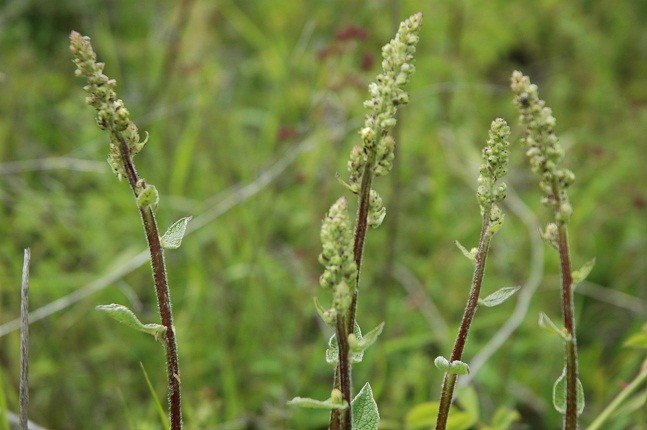Wood sage
(Teucrium scorodonia)

Description
Teucrium scorodonia, common name the woodland germander or wood sage, is a species of flowering plant in the genus Teucrium of the family Lamiaceae. It is native to Western Europe and Tunisia, but cultivated in many places as an ornamental plant in gardens, and naturalized in several regions (New Zealand, Azores, and a few locales in North America). Teucrium scorodonia reaches on average 30–60 centimetres (12–24 in) of height. It is a hairy herbaceous perennial with erect and branched stems. The leaves are petiolate, irregularly toothed, triangular-ovate to oblong shaped, lightly wrinkled. The inflorescence is composed by one-sided (all flowers "look" at the same side) pale green or yellowish flowers bearing four stamens with reddish or violet filaments. These flowers grow in the axils of the upper leaves and are hermaphrodite, tomentose and bilabiate but lack an upper lip, as all Teucrium ones. The flowering period extends from June through August. These plants are mainly pollinated by Hymenoptera species. These plants prefer sandy soils in woodland and acid heaths, at an altitude of 0–1,500 metres (0–4,921 ft) above sea level. Teucrium is a cosmopolitan genus of flowering plants in the family Lamiaceae, commonly known as germanders. Plants in this genus are perennial herbs or shrubs, with branches that are more or less square in cross-section, leaves arranged in opposite pairs, and flowers arranged in thyrses, the corolla with mostly white to cream-coloured, lobed petals. Plants in the genus Teucrium are perennial herbs or shrubs with four-cornered stems, often with simple hairs and sessile glands. The leaves are arranged in opposite pairs, simple or with three leaflets sometimes with lobed or serrated edges. The flowers are arranged in a thyrse, sometimes in a cyme in leaf axils. The flowers have five more or less similar sepals fused at the base, and the corolla is white or cream-coloured with five lobes forming two lips. The upper lip is usually much reduced in size and the lower lip has three lobes, the central lobe usually larger than the side lobes. There are four stamens attached near the base of the petals and the fruit is a schizocarp with four segments. The genus Teucrium was first formally described in 1753 by Carl Linnaeus in Species Plantarum. The name Teucrium was used by Pedanius Dioscorides for several species in this genus, and is believed to refer to King Teucer of Troy who used the plant in his medicine.
Taxonomic tree:







